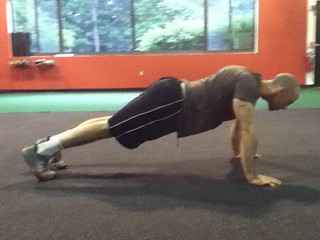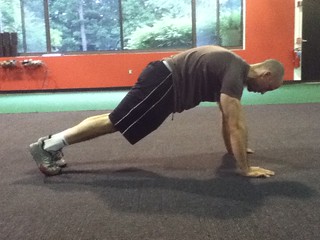Yesterday I had the pleasure of attending the filming of Eric Cressey and Mike Reinold’s next phase in their Functional Stability Training series, Functional Stability Training – Upper Body.
As an FYI: the first two modalities, Functional Stability Training – Core, and Functional Stability Training – Lower Body, can be accessed HERE.
Think of the whole shebang as on par with The Dark Knight trilogy. All stand alone pieces are equally badass in their own right, but as a whole……can be considered mindblowing.
Yesterday entailed the filming of the “hands-on” or lab portion, and Cressnold (as I like to call them) took volunteers from the audience and placed them through a few shoulder screens/assessments to demonstrate that not all shoulders are created equal.
More importantly, they took it as an opportunity to demonstrate to everyone that how “we” approach treating and addressing certain dysfunctions can drastically change from one shoulder to the next.
And, as it happened, I ended up being one of their guinea pigs, as seen below in a “behind the scenes” shot.
Basically, it went down like this:
Mike: would anyone be willing to take their shirt off?
[dead sprint from my seat]
Me: Can The Rock smell what’s cookin? Does a bear shit in the woods? Does Dolly Parton sleep on her back? YOU WANT MY PANTS OFF TOO????
I suspect that my 20 minute shirtless cameo will be a huge selling point for Eric and Mike when they finally release this module.
Learn the secrets behind an effective shoulder screen/assessment.
Find out how both Mike and Eric choose what treatment and corrective exercise progressions come into play based off a thorough shoulder assessment.
Watch Tony squeeze his pecs and turn a piece of coal into a diamond!
Okay, all facetiousness aside, it was a FANTASTIC event and it should come as no surprise that Mike and Eric helped make a lot of people a heckuva lot smarter.

One key point that I want to discuss today which Mike hit on briefly during one of his talks, is the notion of tendinitis and tendinosis.
Many people think the two are one in the same and that both should be lumped together (like Star Wars and Star Trek. You know, cause both take place in space) with regards to how we go about assessing and addressing each.
This is wrong, and here’s why.
– itis = is the Greek suffix for inflammation.
– osis = is the Greek suffix which denotes actions, conditions, or states. In the context of this conversation it refers to degeneration.
Someone with acute elbow pain or discomfort for example has tendinITIS. You can palpate the area, the person will say “ow,” tell them to apply ice, take some ibuprofen for a few days, lay low on things that exacerbate symptoms, and they should be fine within a few weeks, if not days.
Conversely, someone with a more chronic, insidious condition has tendinOSIS. You can palpate the area, the person will probably want to punch you in the face (but it could just as easily be more acute discomfort like the example above), but in this case, despite icing, popping NSAIDS, and rest, the condition, even after six months hasn’t gotten any better.
The problem here is actual degeneration of the joint, and it’s in this scenario we need to look more outside the box.
In keeping with the elbow example, someone with tendinitis will typically – not always – respond well with dedicated manual therapy on the problem area itself alongside your standard ice/rest protocol.
If the issue doesn’t resolve and it continues for months on end (tendinosis), and as Mike pointed out, sometimes you need to look elsewhere along the kinetic chain to see what’s the TRUE culprit.
It’s something he’s routinely referred to as The Kinetic Chain Ripple Effect.
When dealing with a more chronic issue, you still need to look at the affected area (in this case the elbow), but you also need to look at other factors elsewhere.
You can treat the elbow all you want with manual therapy and corrective exercise, but if someone has atrocious T-spine mobility, is overly kyphotic, and has forward head posture, wouldn’t it make sense to address those “red flags?”
Interestingly, Mike worked with someone yesterday during his presentation who had elbow pain, and one of the first things he did was test her grip strength bilaterally. It should come as no surprise that she was weaker on the side which hurt to squeeze.
After coaching her on her posture – getting the shoulders back and posteriorly tilted, learning to brace the abs and posteriorly tilt the pelvis, and to tuck the chin – he retested her grip and she immediately saw a 16% increase (and it was less painful!).
And all he did was place her into better alignment!
There’s no doubt that she would still need soft tissue work to address her elbow, but many of her symptoms were corrected by taking a closer look at her shoulder and head position!
All of this to say: if you’re a personal trainer or strength coach and have a client with a nagging injury that hasn’t gotten better with traditional ice, rest, and NSAIDS, it’s a safe bet that it’s not just a simple case of tendinitis, and you’re dealing with something more chronic like a tendinosis (or, actual degeneration of a joint).
Step one would be to refer out to your network and have him or her work with a manual therapist.
Step two, and something which you can take more of the reigns on, would be to keep an eye out for other factors such as posture or any movement dysfunctions who may notice.
More often than we think an “elbow issue” isn’t just something that’s wrong with the elbow. Likewise, a “knee issue” could be something fishy going on elsewhere. We can’t assume it’s solely the knee.
I like to put all the blame on CrossFit….;o) Just kidding. Kinda.
What are you thoughts? Agree? Disagree? Tomato? Tomahto? I’d like to hear everyone else’s thoughts on the matter.








